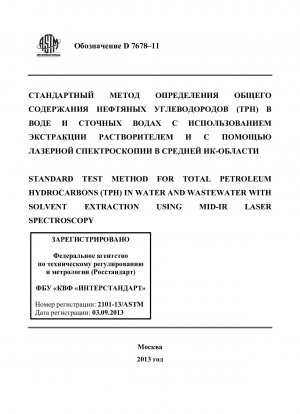ASTM D7678-11
Standard Test Method for Total Petroleum Hydrocarbons (TPH) in Water and Wastewater with Solvent Extraction using Mid-IR Laser Spectroscopy
- Standard No.
- ASTM D7678-11
- Release Date
- 2011
- Published By
- American Society for Testing and Materials (ASTM)
- Status
- Replace By
- ASTM D7678-17
- Latest
- ASTM D7678-17(2022)
- Scope
The presence and concentration of total petroleum hydrocarbons, as well as oil and grease, in domestic and industrial wastewater is of concern to the public because of its deleterious aesthetic effect and its impact on aquatic life.
Regulations and standards have been established that require monitoring of total petroleum hydrocarbons as well as oil and grease in water and wastewater.
1.1 This test method covers the determination of total petroleum hydrocarbons (TPH) in water, and waste water, that are extractable from an acidified sample with a cyclic aliphatic hydrocarbon (for example cyclohexane), and measured by IR absorption in the region of 1370 -1380 cm-1 (7.25 -7.30 microns). Polar substances are removed by clean-up with Florisil.
1.2 The method also considers the volatile fraction of petroleum hydrocarbons which is lost by gravimetric methods that require solvent evaporation prior to weighing, as well as by solventless IR methods that require drying of the employed solid phase material prior to measurement. Similarly, a more complete fraction of extracted petroleum hydrocarbon is accessible by this method as compared to GC methods that use a time window for quantification, as petroleum hydrocarbons eluting outside these windows are also quantified.
1.3 This method defines oil and grease in water and wastewater as that which is extractable in the test method and measured by IR absorption in the region of 1370-1380 cm-1
(7.25 – 7.30 microns).1.4 This method covers the range of 0.5 to 1000 mg/L and may be extended to a lower or higher level by extraction of a larger or smaller sample volume collected separately.
1.5 The values stated in SI units are to be regarded as standard. No other units of measurement are included in this standard.
1.6 This standard does not purport to address all of the safety concerns, if any, associated with its use. It is the responsibility of the user of this standard to establish appropriate safety and health practices and determine the applicability of regulatory limitations prior to use.
ASTM D7678-11 Referenced Document
- ASTM D1129 Standard Terminology Relating to Water
- ASTM D1141 Standard Practice for the Preparation of Substitute Ocean Water
- ASTM D1192 Standard Guide for Equipment for Sampling Water and Steam in Closed Conduits
- ASTM D1193 Standard Specification for Reagent Water
- ASTM D2777 Standard Practice for Determination of Precision and Bias of Applicable Methods of Committee D-19 on Water
- ASTM D3370 Standard Practices for Sampling Water from Closed Conduits
- ASTM D3921 Standard Test Method for Oil and Grease and Petroleum Hydrocarbons in Water
- ASTM D5847 Standard Practice for Writing Quality Control Specifications for Standard Test Methods for Water Analysis
- ASTM D7575 Standard Test Method for Solvent-Free Membrane Recoverable Oil and Grease by Infrared Determination
- ASTM E168 Standard Practices for General Techniques of Infrared Quantitative Analysis
- ISO 9377-2 Water quality - Determination of hydrocarbon oil index - Part 2: Method using solvent extraction and gas chromatography
ASTM D7678-11 history
- 2022 ASTM D7678-17(2022) Standard Test Method for Total Oil and Grease (TOG) and Total Petroleum Hydrocarbons (TPH) in Water and Wastewater with Solvent Extraction using Mid-IR Laser Spectroscopy
- 2017 ASTM D7678-17 Standard Test Method for Total Oil and Grease (TOG) and Total Petroleum Hydrocarbons (TPH) in Water and Wastewater with Solvent Extraction using Mid-IR Laser Spectroscopy
- 2011 ASTM D7678-11 Standard Test Method for Total Petroleum Hydrocarbons (TPH) in Water and Wastewater with Solvent Extraction using Mid-IR Laser Spectroscopy
